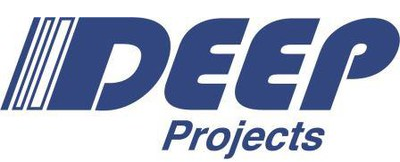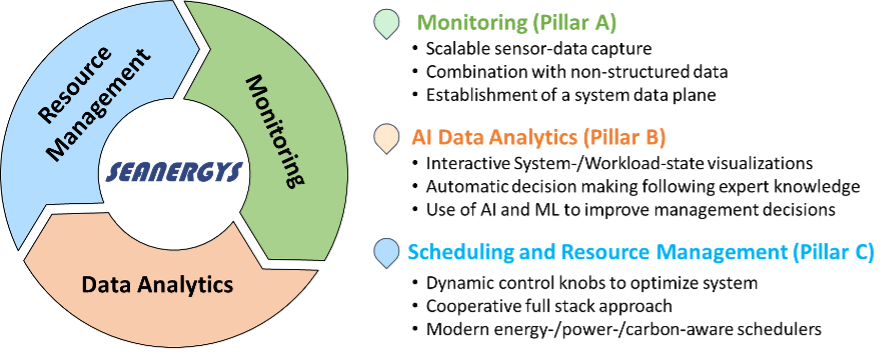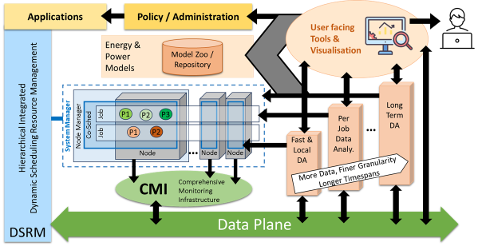
SEANERGYS Concept
SEANERGYS solution is built around a continuous feedback loop that continuously monitors system behaviour utilizing system data, application and workload information as well as unstructured data like scheduling and workflow dependencies and job scripts. It processes this operational data in an AI-based data analytics framework to gain actionable insights on how to improve operations either via automatic and machine-processable hints or via user/administrator-targeted visual analytics. Extended resource management components that allow for adaptive and configurable schedules will support the implementation of the detected optimisation potential and reconfiguration options.
The SEANERGYS solution is implemented via the three pillars, Monitoring, AI Data Analytics, and Scheduling and Resource Management.
To this end, site specific policy and optimisation goal selections and possible actions could include resource adaptation of running workloads;
- to better exploit available power, especially while cheap power is available or power from renewables is at an abundance and perhaps even must be consumed to support grid stability.
- to divert power to components where power is needed most to make progress in the computation, to avoid unnecessary stalls in other parts of a workflow.
- to reduce energy consumption to match application characteristics, e.g., by reducing frequency in memory intensive phases, while increasing it in compute bound sections.
- to fully utilise node capabilities to avoid resource idle times by running complimentary workloads on a single node, allowing applications to safely share infrastructure.
- to remove unneeded or currently not supportable components temporarily from the system, e.g., in case of temporary power shortages or energy intensive high-priority jobs.
Resources optimized include:
- Number of threads/processes per job
- Job placement across node/system topologies
- Cache/accelerator/network partitioning
- Memory per process
- Power-aware scheduling decisions based on external inputs (e.g., energy grid status)
This continuous optimization balances performance, energy efficiency, and site-specific constraints and policies — such as power budgets or workload priorities.

System Architecture
SEANERGYS builds on familiar HPC infrastructure while introducing next-gen adaptability. It focuses on flexible integration, starting with Slurm as a baseline scheduler and supporting future expansion or replacements where needed.
Key Enhancements:
- Co-scheduling: Run multiple workloads safely on the same node
- Workflow-aware resource sharing: Maximize throughput, minimize idle resources
- Compatibility: Works with or without compute accelerators (e.g., GPUs)
Unified Monitoring Infrastructure
SEANERGYS includes a scalable, conflict-free monitoring system that aggregates:
- Node-level hardware and software telemetry
- Control plane insights (e.g., cooling systems, grid data)
- Application-level voluntary reporting (e.g., resource needs, progress)
All data flows through a standardized system-wide data plane, replacing fragmented monitoring setups and enabling powerful multi-layer analysis.
AI-Driven Analytics (AIDAS)
Data is processed by AIDAS, an advanced AI-based analytics system capable of both short-term feedback loops and long-term behavioral modeling.
Capabilities include:
- Real-time steering of system behavior
- Offline training using historical data (“Model Zoo”)
- Visual analytics for admins and developers
- Insight generation for tuning applications and system policies
Dynamic & Hierarchical Resource Management
Insights from AIDAS are fed into the DSRM (Dynamic Scheduling & Resource Management) system, which makes real-time decisions across multiple layers:
- System Manager: Enforces global power/energy constraints
- Node Manager: Adjusts frequencies, cache, bandwidth, etc.
- Co-Scheduler: Manages resource sharing across apps/workflows
- Job Manager: Tunes application-wide resource use within user space
Together, these components ensure adaptive, fair, and secure resource usage — completing SEANERGYS’ continuous optimization cycle.
SEANERGYS builds on the standard software stack architectures we find in today’s HPC systems, unifies software packages where currently multiple solutions are used across hosting sites and provides the needed interfaces to administrators and users/application developers to set policies, adjust behaviour and ultimately achieve efficient execution with optimal resource allocation. The reliance on such existing software will lower the learning curve, accelerate achievement of production TRL levels and increase acceptance by HPC centres and their operators.



